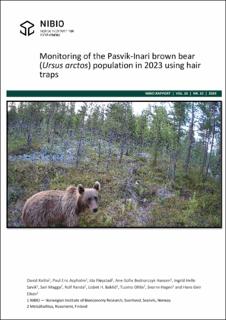| dc.description.abstract | Since 2005, the population of the trans-border brown bear (Ursus arctos) in Trilateral Park Pasvik-Inari (Norway-Finland-Russia) has been monitored by using genetic analyses of hair and faeces collected randomly in the field. A more systematic method using hair traps every fourth year was initiated in 2007 to collect brown bear hairs for genetic analysis. The method consisted of 56 hair traps in Norway, Finland and Russia in a 5 x 5 km2 grid cell system (ca 1400 km2). The project was repeated in 2011, 2015, 2019 and now in 2023. This season’s sampling was carried out in Pasvik (Norway) - Inari (Finland) area (43 squares, 1075 km2), using the same methodology as in the previous studies. A total of 97 samples were collected, where 45 samples came from Finland and 52 samples from Norway. In the bear specific analysis, 71 (73 %) of the 97 hair samples were positive. A complete DNA profile could be determined for 63 of the positive samples. In total, 22 different bear individuals were detected (10 females and 12 males). Of these 22 bears, 12 bears were detected in previous years, while 10 were previously unknown bears. In total, 13 bears were detected in Finland and 11 bears in Norway. This year’s sampling has the 2nd highest success rate in number of individuals detected per grid square, with 0,51 individual per grid square compared to 0,81 individuals in 2019 (highest success rate), 0,49 in 2015, 0,35 in 2011 and 0,42 in 2009. Our results showed that even with a smaller study area, the hair trap project every 4th year provides valuable information on the brown bear individuals in addition to a random sampling in the field (The National Monitoring Program for brown bears in Norway). | |
